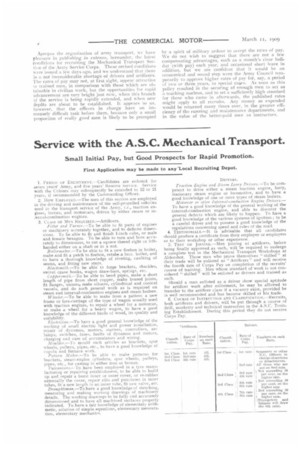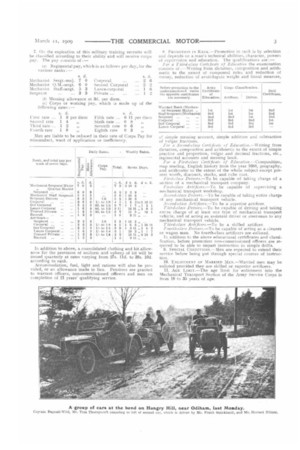Service with the A.S.C. Mechanical Transport.
Page 2

Page 3

If you've noticed an error in this article please click here to report it so we can fix it.
Small Initial Pay, but Good Prospects for Rapid Promotion.
First Application may be made to any 'Local Recruiting Depot.
1. PERIOD OF ENLISTMENT. -Candidates are enlisted fur Leven years' Army, and five years' Reserve Service. Service with the Colours may subsequently be extended to 12 or 21 years, if recommended by the Commanding Officer.
2. How EMFLOVE.D.—The men of this section are employed in the driving and maintenance of the self-propelled vehicles used in the transport service of the Army, i.e., traction engines, lorries, and motorcars, driven by either steam or inxrnal-combustion engines.
3. CLASS OF MEN HEQUIRED.—Artificers.
Fitter and Turner.—To be able to fit parts of engines or machinery accurately together, and to definite dimensions. To be able to fit and finish 1-inch cube, or male and female hexagon. To be able to turn and bore accurately to dimensions, to cut a square thread right or lefthanded either on a shaft or in a nut.
Boilermaker.—To be able to fit a new firebox in boiler, make and fit a patch to firebox, retube a loco. boiler, and to have a thorough knowledge of riveting, caulking of seams, and fitting new stays. Blacksmith.—To be able to forge brackets, shackles, swivel crane hooks, wagon draw-bars, springs, etc.
Coppersmith.—To be able to bend pipes, make a short length of pipe from sheet copper, .make brazed joints, fit flanges, unions i make oilcans, cylindrical and conical vessels, and do such general work as is required on steam and internal-combustion engines and steam boilers. Wkeeler.—To be able to make from a pattern a new frame or fore-carriage of the type of wagon usually used with traction engines, to repair a wheel for a motorcar. or make a wheel for a heavy wagon, to have a good knowledge of the different kinds of wood, its quality and Electrician.—To have a good general knowledge of the working of small electric light and power installation, repair of dynamos, motors, starters, controllers, arc lamps, switches, fuses, faults of dynamos and motors, charging and care of accumulators and wiring.
Moultier.—To mould such articles as brackets, spur wheels, pulleys, pipes, etc., to have a good knowledge of cupola and furnace work.
Pattern Maker.—To be able to make patterns for brackets, steam-engine cylinders, spur wheels, pulleys, pipes, etc.., for casting in either iron or bronze.
Vulcanisers.— To have been employed in a tyre manufacturing or repairing establishment, to be able to build up and repair a burst inner or outer cover, or re-rubber externally the cover, repair slits and punctures in inner tubes, fit a new length in an inner tube, fit new valve, etc.
Draughtsman.—To have a good knowledge of sketching, measuring and making working drawings of machinery details. The working drawings to be fully tend accurately dimensioned and to have all machined surfaces properly indicated. To have a fair knowledge of elementary arith• metic, solution of simple equations, elementary mensuralion, elementary mechanics. Traction Engine and Steam Lorry Drivers.—To be competent to drive either a steam traction engine, lorry, stationary steam engine or locomotive, and to have a good knowledge of one or more types of steam boilers. Motorcar or other internal-eombustion Engine Drivers.—
To have a good knowledge of the general working of the internal-combustion engine, and able to discover the general defects which are likely to happen. To have a good knowledge of the various systems of ignition ; to be a careful driver and to possess a good knowledge of the regulations concerning speed and rules of the road. 4. TESTIMONIALS.—It is advisable that all candidates should produce a certificate from their employer or employers as to their workshop or other experience. 5. TEST ON JOINING.—Men joining ae artificers, before being finally approved as such, will be required to undergo a complete test in the Mechanical Transport Workshops at Aldershot. Those men who prove themselves " skilled " at their trade will be enlisted as "Artificers " and will receive the fourth rate of Corps Pay on completion of the recruits' course of training Men whose standard of work is not considered " skilled " will be enlisted as drivers and trained as such.
Should a man enlisted as a driver show special aptitude for artificer work after enlistment, he may be allowed to transfer to the artificer class if a vacancy exist, provided he is well recommended and has become skilled at his trade.
G. COURSE OF INSTRUCTION AND CeassiFicaTtote---Reeruits, both artificers and drivers, will he put through a course of drill, musketry and technical instruction in the A.S.C. Training Establishment. During this period they do not receive Corps Pay. 7. On dm expiration of this military training recruits will be classified according to their ability and will receive corps pay. The pay consists of :—
(a) Regimental pay, which is as follows per day, for the various ranks :—
In addition to above, a consolidated clothing and kit allowance for the provision of uniform and upkeep of kit will be issued quarterly at rates varying from 27s. Ild. to 38s. 10d. according to rank.
Accommodation, fuel, 'light and rations will also be provided, or an allowance made in lieu. Pensions are granted to warrant officers, non-commissioned officers and men on completion of 21 years' qualifying service.
;4. PROMOTION IN R.ANK.—Promotion in rank is by selection arid depends on a man's technical abilities, character, powers of supervision and education. The qualifications are :—
. For a Third-class Certlficate of Education the examination consists of :—Writing from dictation, composition and arithmetic to the extent of compound rules and reduction of money, reduction of avoirdupois weight and lineal measure, o!' simple messing account, simple addition and s ibtraction of vulgar fractions,
For a Second-class Certificate of Education.—Writing from dictation, composition and arithmetic to the extent of simple practice and proportion, vulgar and decimal fractions, etc., regimental accounts and messing book.
For a First-class Certificate of Education.—Composition, rnap reading, English history from the year 1688, geography, and arithmetic to the extent of the whole subject except present worth, discount, stocks, and cube root.
First-class Drivers.—To be capable of taking charge of a section of a mechanical transport company.
First-class Artificers.—To be capable of supervising a mechanical transport workshop.
Second-class Drivers.--To be capable of taking entire charge of any mechanical transport vehicle.
Second-class Artificers.—To be a superior artificer.
Third-class Drivers.—To be capable of driving and taking entire charge of at least one type of mechanical transport vehicle, and of acting as assistant driver or steersman to any mechanical transport vehicle.
Third-class Artificers.—To be a skilled artificer.
Fourth-ciacs Drivers.—To he capable of acting as a cleaner or wagon man. No fourth-class artificers are enlisted.
In addition to the above educational certificates and classification, before promotion non-commissioned officers are required to be able to impart instruction in simple drills.
9. SPECIAL CONDITIONS.--Men are expected to extend their service before being put through special courses of instruction.
10, ENLISTMENT OF MARRIED MEN.—Married men may be enliated provided they are skilled or superior artificers. 11, AGE Li:arr.—The age limit for enlistment into the Mechanical Transport Section of the Army Service Corps is from 18 to 35 years of age.






















